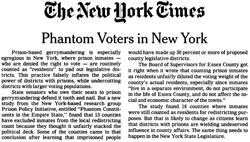Phantom Voters in New York — New York Times editorial
by New York Times, July 23, 2007
 Prison-based gerrymandering is especially egregious in New York, where prison inmates — who are denied the right to vote — are routinely counted as “residents” to pad out legislative districts. This practice falsely inflates the political power of districts with prisons, while undercutting districts with larger voting populations.
Prison-based gerrymandering is especially egregious in New York, where prison inmates — who are denied the right to vote — are routinely counted as “residents” to pad out legislative districts. This practice falsely inflates the political power of districts with prisons, while undercutting districts with larger voting populations.
State senators who owe their seats to prison gerrymandering defend it tooth and nail. But a new study from the New York-based research group Prison Policy Initiative, entitled “Phantom Constituents in the Empire State,” found that 13 counties have excluded inmates from the local redistricting count because they thought it unfairly stacked the political deck. Some of the counties came to that conclusion after learning that imprisoned people would have made up 30 percent or more of proposed county legislative districts.
The Board of Supervisors for Essex County got it right when it wrote that counting prison inmates as residents unfairly diluted the voting weight of the county’s actual residents, especially since inmates “live in a separate environment, do not participate in the life of Essex County, and do not affect the social and economic character of the towns.”
The study found 16 counties where inmates were still counted as residents for redistricting purposes. But that is likely to change as citizens learn that districts with prisons are wielding undeserved influence in county affairs. The same thing needs to happen in the New York State Legislature.




[…] linked to New York Times editorial condemning the use of prisoners in counting local populations. (ed: the previous version linked to an earlier story. thanks Peter for the heads […]
[…] In the most recent Newsweek, writer Ben Adler peels back the layered benefits to prisons in upstate New York via the lens of his own family: in 1983, a summer resort run by his great-grandparents was transformed into Sullivan Correctional Facility. As New York state’s prison population swelled from 13,000 in 1970 to over 70,000 today, housing inmates from NYC became a lucrative business for otherwise destitute upstate towns. “Ironically, the prisoners—mostly low-income men of color—bring two things they themselves lack: economic and political power,” writes Adler. That’s because during the Census, those tens of thousands of prisoners are counted in the rural places in which they are imprisoned rather than their homes, even though they cannot vote. The result is an skewed diversion of legislative clout to sparsely-populated, rural towns — often called prison-based gerrymandering. […]